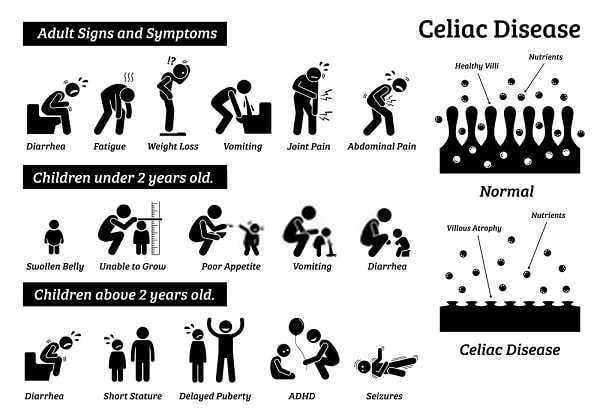Overview of Celiac Disease

Celiac Disease is a chronic condition affecting the small intestine. In patients with celiac disease, the small intestine is damaged and it is unable to absorb specific nutrients. Gluten in the diet, which comes from wheat, barley, and rye, causes a reaction and produces the damage. As a result of the inability to absorb nutrients, an individual with celiac disease will become malnourished, regardless of how much food they eat.
Celiac disease affects one out of every 133 people. It is estimated that 97% of individuals with celiac disease are never diagnosed.
Symptoms of Celiac Disease
Symptoms of celiac disease vary significantly, and can result in a delay in diagnosis. Many symptoms affect the gastrointestinal tract. These include, but are not restricted to: abdominal pain, diarrhea, gas, lactose intolerance, constipation, indigestion, nausea, vomiting, and unexplained weight loss.

As a consequence of the lack of nutrients in the system, other symptoms may develop over time. Individuals may experience unexplained weight loss, fatigue, hair loss, ulcers in the mouth, cramping, seizures, irritability, nosebleeds, depression, and more.
In children, there may be a delay in growth and weight gain, unexplained fussiness, a delay in puberty, and defects in the color and enamel of the teeth.
If you think that you may be suffering from celiac disease, it is important to contact your physician before making any dietary or other lifestyle changes.
Diagnosing Celiac Disease
Only a physician can diagnose celiac disease. First, the symptoms a patient is experiencing may prompt a doctor to run diagnostic testing. Antibody tests to detect antitissue transglutaminase antibodies (tTGA) or anti-endomysium antibodies (EMA) are run using blood samples. Physicians will also run a complete blood count, or CBC, to test for anemia.

Other lab tests may show low albumin, abnormalities in clotting factors, low cholesterol, and high levels of alkaline phosphatase. If a patient receives a positive result on these blood tests, their physician will refer them to a gastroenterologist for an upper endoscopy. This test involves inserting a lighted, flexible endoscope into the mouth to examine the esophagus, stomach, and duodenum. During the procedure, the physician will take a tissue sample from the duodenum. A patient with celiac disease will often have a flattening of the villi within the small intestine.
Treatment for Celiac Disease
Celiac disease is a chronic condition and cannot be cured. Through management of the diet, patients can eliminate symptoms and heal the lining of their small intestine. The dietary changes are life long. Dietary changes heal damage in children within 3-6 months, but it can take up to 3 years for adult patients to experience complete healing. Some celiac patients even try the hcg diet with some success to help them remain symptom free.
Diet and Celiac Disease
Gluten in the diet is the primary cause of damage to the intestines of celiac disease sufferers. Removing foods, beverages, and medications from a diet will make symptoms go away. Gluten is found not only in wheat, but also in other grains including rye, barley, and even oats.

While maintaining a gluten-free diet can be a challenge given the importance of grains to the typical American diet, there are more options available in both grocery stores and restaurants for individuals with celiac disease. In fact, many grocery stores have sections of the grocery store with gluten-free options. When purchasing foods, it is important to read labels carefully, as often there may be hidden sources of gluten in the product. If asked, restaurant can either provide a gluten-free menu or provide specific options. There is greater awareness of celiac disease and other gluten-related dietary restrictions.
To supplement nutrients in a patient’s diet, physicians will sometimes prescribe additional vitamins or other supplements. Some have even tried the hcg diet with some success as another diet to treat the condition. However, a dietician specializing in gluten-free diets can help support patients in developing new eating habits to manage celiac disease.
After diagnosis and a few months of treatment, follow-up testing may be run. These are used to determine how well a patient is responding to treatment. They will not show a cure, but will demonstrate improvement.
Complications of Celiac Disease
For children with celiac disease, they may not reach full height potential if the disease resulted in a slower growth rate. Also, if someone has experienced damage to the dental enamel or coloring, this damage may not improve.
Following a gluten-free diet prevents complications. Celiac disease can cause life-threatening complications if left untreated. These include autoimmune disorders, osteoporosis and other bone diseases, some intestinal cancers, anemia, hypoglycemia, liver disease, and fertility issues.
Cause of and Predisposition for Celiac Disease
There is no known cause of celiac disease and as a result, there is no known way to prevent it. It can develop at any time, regardless of age. Individuals who have a family member with the disease are more likely to develop celiac disease. Women are at greater risk as are those of European ancestry.
There are some conditions that seem to predispose individuals to celiac disease.
These include Down Syndrome, Addison’s disease, intestinal cancer, autoimmune disorders, thyroid disease, lactose intolerance, and Type 1 diabetes.
If any of the above conditions describe a patient, celiac disease should be considered as a possible diagnosis if they are experiencing relevant symptoms.
Resources for Individuals with Celiac Disease
In addition to medical personal, such as doctors and nurses, as well as dieticians, there are other sources of support for individuals with celiac disease. Support groups can help patients adjust to the diagnosis and managing diet. Dieticians and others with the disease can assist patients in finding sources for gluten-free products.
Other organizations can provide additional resources and information. The Celiac Disease Foundation (www.celiac.org) provides education to both patients and medical personnel. It also provides advocacy and support services. The Gluten Intolerance Group (www.gluten.net) provides patient and professional support through national outreach programs and services. The Celiac Sprue Association (www.csaceliacs.org) is a national organization that also has local support groups. These sites all offer education, recipes, and other resources.
The prognosis for patients with celiac disease is excellent. As long as individuals maintain a gluten-free diet, damage to the intestines will be reversed, further damage will be prevented, and symptoms will disappear. Lack of adherence to the diet will cause the symptoms of the disease to present again.

